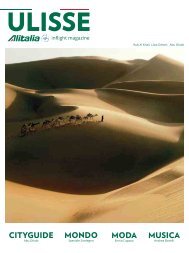Create successful ePaper yourself
Turn your PDF publications into a flip-book with our unique Google optimized e-Paper software.
EXPLORE ARTE E MUSEI<br />
Il Museo Nazionale Etrusco<br />
di Villa Giulia a Roma<br />
Il Sarcofago degli Sposi, VI secolo a.C.<br />
Foto Mauro Benedetti<br />
Ai piedi della collina dei Parioli, protetta dal verde di Villa<br />
Borghese, la severa facciata cinquecentesca della Villa<br />
Giulia si offre a chi giunge dalla via Flaminia nella sua<br />
composta eleganza. Fu costruita per volontà di Papa Giulio<br />
III Ciocchi del Monte (1550-1555), affabile umanista, che ne<br />
fece la sua residenza suburbana, affidandone il progetto e la realizzazione<br />
ai più famosi artisti dell’epoca, a cominciare da Jacopo<br />
Barozzi da Vignola, a Bartolomeo Ammannati e al Vasari. E si<br />
racconta che ci sia stata la supervisione perfino di Michelangelo. Il<br />
cuore della villa è rappresentato dalla loggia dell’Ammannati che<br />
dà accesso al celebre Ninfeo, costruito intorno a una fontana centrale,<br />
progettata e scolpita dal Vasari e dall’Ammannati con statue<br />
di cariatidi e di divinità fluviali: in questo luogo fresco, riparato dal<br />
sole ardente, celebrato per la sua compiuta perfezione dai grandi<br />
dell’epoca, si tenevano feste che duravano un intero giorno! È in<br />
questo settore che si svolge, dal 1947, il Premio letterario Strega. La<br />
Villa accoglie dal 1889 il più importante museo del mondo dedicato<br />
agli Etruschi: vi sono esposti capolavori assoluti dell’arte antica,<br />
dal notissimo Sarcofago degli Sposi al possente Apollo di Veio, alla<br />
Cista Ficoroni, straordinario beauty case dell’antichità finemente<br />
decorato, solo per citarne alcuni.<br />
Attraverso le numerose sale del Museo i ricchi corredi funerari, le<br />
variegate decorazioni degli edifici sacri e i doni offerti alle divinità<br />
nei santuari raccontano una storia complessa, nella quale ogni città<br />
del mondo etrusco ha un suo tratto distintivo. E come non ricordare<br />
che al piano nobile della dimora papale fa bella mostra di sé la più<br />
importante collezione ottocentesca di oreficerie? Frutto dell’attività<br />
dei Castellani, famosi orafi e antiquari, le cui creazioni affascinarono<br />
l’aristocrazia e l’alta borghesia del tempo.<br />
A cura della Soprintendenza per i Beni Archeologici<br />
dell’Etruria meridionale<br />
THE NATIONAL ETRUSCAN MUSEUM OF VILLA<br />
GIULIA IN ROME<br />
At the bottom of the Parioli hill, protected by the green landscape<br />
of the Villa Borghese, the severe sixteenth century facade of Villa<br />
Giulia offers itself to those who come from Via Flaminia with its<br />
composed elegance. It was built by the will of Pope Giulio the 3rd<br />
Ciocchi del Monte (1550-1555), affable humanist, who elected it as<br />
suburban residence, entrusting the project and it’s accomplishment<br />
to the most famous artists of that time, starting from Jacopo Barozzi<br />
da Vignola, up to Bartolomeo Ammannati and Vasari. And it is said<br />
that there has even been the supervision of Michelangelo.<br />
The heart of the Villa is represented by the loggia of the Ammannati<br />
which introduces to the famous nymphaeum, built around a central<br />
fountain and designed and carved by Vasari and Ammannati with<br />
caryatid statues and fluvial divinities. Parties that lasted a whole<br />
day were held in this place: cool, repaired from the hot sun and<br />
celebrated by the great figures of the time for its accomplished<br />
perfection! Nowadays, in this same area of the Villa is held since<br />
1947 the Strega literary prize.<br />
The Villa hosts since 1889 the world’s most important museum<br />
dedicated to the Etruscans: absolute masterworks of the ancient<br />
art are displayed, from the well-known Sarcophagus of the Spouses<br />
to the powerful Apollo from Veio, just to name some.<br />
Through the Museum’s numerous rooms, the rich funerary kits, the<br />
variegated decorations of the sacred buildings and the gifts offered<br />
to the divinities of the shrines tell a complex story where every city<br />
of the Etruscan world has its distinctive trait.<br />
And how can be forgotten that at the noble floor of the Pope’s<br />
residence is proudly exhibited the most important jewelry collection<br />
of the nineteenth century? An invaluable collection coming from<br />
the activity of the Castellani family: famous goldsmiths and<br />
antiquarians, whose creations fascinated the aristocracy and<br />
upper class of the time!<br />
By The Soprintendenza Beni Archeologici<br />
dell’Etruria Meridionale<br />
12 ULISSE MARZO 2015<br />
MUSEO NAZIONALE ETRUSCO DI VILLA GIULIA<br />
piazzale di Villa Giulia, 9, 00196 Roma, Italia<br />
tel. (+39) 06 3226571; fax (+39) 06 3202010<br />
E-mail: sba-em@beniculturali.it<br />
PEC: mbac-sba-em@mailcert.beniculturali.it<br />
www.villagiulia.beniculturali.it<br />
La facciata del piano nobile di Villa Giulia vista dalla Loggia dell’ Ammannati.<br />
Foto Mauro Benedetti




